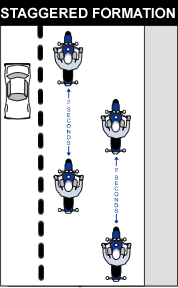Additional Formats
Section 5 of 7
Ride Within Your Abilities
This handbook cannot teach you how to control direction, speed, or balance. You learn this by taking professionally taught motorcycle rider courses, practicing, knowing your abilities, and riding within them.
Basic Vehicle Control
Body Position
To control a motorcycle:
- Posture—Sit so you can use your arms to control the motorcycle rather than to hold yourself up.
- Seat—Sit far enough forward so your arms are slightly bent when holding the handle grips. Bending your arms permits you to press on the handlebars without having to stretch and reduces arm fatigue.
- Hands—Hold the handlegrips firmly. Start with your right wrist flat so you will not accidentally use too much throttle. Also, adjust the handlebars so your hands are even with or below your elbows. This allows you to use the proper muscles for precision steering.
- Knees—Keep your knees against the gas tank to help with your balance as you turn the motorcycle.
- Feet—Keep your feet firmly on the footrests for balance. Do not drag your feet; you could lose control of the motorcycle. Keep your feet near the controls. Do not point your toes downward—they may get caught between the road and the footrests.
Shifting Gears
There is more to shifting gears than simply getting the motorcycle to pick up speed smoothly. Learning to use the gears when downshifting, turning, or starting on hills is important for safe motorcycle operation.
Shift down through the gears with the clutch as you slow or stop. Remain in first gear while stopped so you can move out quickly if needed.
Ride slowly enough when you shift into a lower gear or the motorcycle will lurch and the rear wheel may skid. When riding downhill or shifting into first gear you may need to slow to downshift safely. Work toward a smooth, even clutch release especially when downshifting.
It is best to change gears before starting a turn. However, sometimes you may need to shift while in the turn. Remember to shift smoothly because a sudden change in power to the rear wheel can cause a skid.
Braking
Your motorcycle has two brakes: one for the front wheel and one for the rear wheel. When making a normal, nonemergency stop, use both brakes at the same time and downshift. The front brake has more stopping power, providing three-quarters of your total stopping power. The front brake is safe to use when used properly.
REMEMBER:
- Use both brakes every time you slow or stop. Using both brakes for “normal” stops helps you develop the proper habit and skill of using both brakes correctly, which you may need in an emergency. Squeeze the front brake and press down on the rear brake. Grabbing at the front brake or jamming down on the rear brake can cause the brakes to lock and result in control problems.
- If you know the technique, using both brakes in a turn is possible, although it should be done very carefully. When you lean the motorcycle, some of the traction is used for cornering and less traction is available for stopping. A skid can occur if you apply too much brake. Also, using the front brake incorrectly on a slippery surface may be hazardous. Use caution and gently squeeze the brake lever, never “grab” it.
- Some motorcycles have integrated braking systems that link the front and rear brakes together when you apply the rear brake pedal (consult your owner’s manual).
Turning
Riders often try to take curves or turns too fast. When they cannot hold the turn, they end up crossing into another lane of traffic or going off the road. In some cases, riders overreact and brake too hard causing a skid and loss of control. Approach turns and curves with caution.
Use four steps for better control:
- Slow-Reduce your speed before the turn by rolling off the throttle and, if necessary, applying both brakes.
- Look-Look through the turn to where you want to go. Turn only your head, not your shoulders, and keep your eyes level with the horizon.
- Press-To turn, the motorcycle must lean. To lean the motorcycle, press on the handle grip in the direction of the turn. Press left-lean left-go left. Press right-lean right-go right. Higher speeds and/or tighter turns require the motorcycle to lean more.
- Roll-Roll on the throttle through the turn to stabilize suspension. Maintain steady speed or accelerate gradually through the turn. This will help keep the motorcycle stable.
In normal turns, the rider and the motorcycle should lean together at the same angle.
In slow tight turns, the rider should keep his or her body straight and only lean the motorcycle.
U-turns
Completing U-turns on a motorcycle requires you to maintain control and balance to maneuver through a tight U-turn. Here are some tips for completing U-turns successfully:
- Look—Look through the turn to where you want to go. Turn only your head, not your shoulders, and keep your eyes level with the horizon.
- Friction Zone—The friction zone is the area of the clutch between completely engaged and completely released. Riding within the friction zone will give you more control through the turn.
- Dragging the Rear Brake—Dragging the rear brake is the practice of utilizing the rear brake to control the bike speed and maintain stability, such as in a U-turn. The front brake should not be used as it could cause the bike to tip over.
- Centralize Weight—A motorcycle will be easier to maneuver when the weight is kept close to the bike. Keep your feet on the footrests and, if necessary, apply weight to the outside footrests to equalize balance.
- Practice—Practice executing U-turns in an empty open parking lot. Start with wide U-turns and gradually tighten the turning radius. Also, practice U-turns in both directions by riding in figure 8 patterns until you are comfortable with U-turns in both right and left directions.
Keeping Your Distance
The best protection you can have is distance-a “cushion of space”-all around your motorcycle. If someone else makes a mistake, distance gives you:
- Time to react.
- Space to maneuver.
Lane Positions
In some ways, the size of the motorcycle can work to your advantage. Each traffic lane gives a motorcycle three paths of travel, as indicated in the illustration.
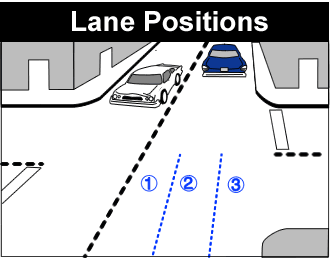
Your lane position should:
- Increase your ability to see and be seen.
- Avoid others’ blind spots.
- Protect your lane from other drivers.
- Communicate your intentions.
- Help you avoid wind blasts from other vehicles.
- Provide an escape route.
Select the appropriate lane position to maximize your space cushion and make yourself more visible to others.
In general, there is no “best lane position” for motorcycle riders to be seen and maintain a space cushion around the motorcycle. Position yourself in the lane that allows the most visibility and space around you. Change your lane position as traffic situations change. Ride in paths 2 or 3 if vehicles and other potential problems are on your left side. If vehicles are on both sides of you, the center of the lane (path 2) is usually the best option. Riding closer to the center portion of your lane helps to keep other vehicles from sharing the lane.
The oily strip in the center portion of the lane is usually no more than two feet wide. Unless the road is wet, the average oily center strip permits adequate traction on which to ride safely. You can ride just to the left or right of the oily strip and still be within the center of the lane. Avoid riding on oil and grease buildups.
Carpool/High Occupancy Vehicle (HOV) Lanes
A carpool lane is a special freeway lane used only for carpools, buses, motorcycles, or decaled low-emission vehicles. The pavement in this lane is marked with a diamond symbol and the words “Carpool Lane.” These lanes are also known as high-occupancy vehicle (HOV) lanes. Do not cross over double parallel lines to enter or exit any carpool lane except at designated entry or exit places. Motorcyclists are allowed to use carpool/HOV lanes, unless otherwise posted.
Toll Highways and Vehicle Crossings: Using Transponders or Electronic Payment Devices
In California, high occupancy toll (HOT) lanes and toll highways are fee-paid roadways used in heavily traveled areas to relieve traffic congestion.
Commuters traveling on toll highways or using HOT lanes may purchase transponders, which track their vehicle’s usage of these roadways. Transponders allow drivers to pay toll fees through electronic billing.
When using a transponder or other electronic payment device, motorcyclists are allowed to place the payment device in five locations (on the motorcycle or carried by the rider), as long as the toll reader can detect the device.
The locations are:
- In the motorcyclist’s pocket.
- Inside a cycle net draped across the gas tank of the motorcycle.
- On the license plate device, if the toll operator provides such a device.
- In a storage compartment on the motorcycle.
- On the windshield of the motorcycle.
Following Another Vehicle
“Following too closely” (tailgating) could be a factor in collisions involving motorcyclists. In traffic, motorcycles need as much distance to stop as other vehicles. Normally, you should maintain a two-second following distance.
To gauge your following distance:
- Ahead of you, pick out a marker such as a pavement marking or lamp post.
- When the rear bumper of the vehicle ahead of you passes the marker, count off the seconds: “one-thousand-one, one-thousand-two.” If you reach the marker before you reach “one-thousand-two,” you are following too closely.
- A two-second following distance gives you a minimum amount of space to stop or swerve, if the driver ahead stops suddenly. It also gives you a better view of potholes and other road hazards.
- Increase following distance when the motorcycle is towing a trailer.
- You will need a larger space cushion if your motorcycle takes longer than normal to stop. Open up a three-second or more following distance when the pavement is slippery, you cannot see through the vehicle ahead, or traffic is heavy.
- When you are stopped, keep well behind the vehicle ahead of you. This provides an escape route if a driver behind you is traveling too quickly or the vehicle ahead starts to back up.
- When behind a vehicle, ride where the driver can see you in his or her rearview mirror.
If you ride in the left or right portion of the lane, the driver may see you in his or her side view mirror. If the traffic situation allows, the center lane position is usually the best place for you to be seen by the driver in his or her rearview mirror and to prevent other vehicles from sharing your lane.
Being Followed
When you speed up to lose a tailgater, you only end up with someone tailgating you at a higher speed.
A better way to handle tailgaters is to allow them to pass you. If you cannot do this, slow down and open up extra space ahead of you. This will allow space for both you and the tailgater to stop. This will also encourage the tailgater to pass. But if the tailgater does not pass, you have at least given yourself and the tailgater more time and space to react in case an emergency develops.
Passing and Being Passed
Passing and being passed by a larger vehicle is not much different than with a smaller passenger vehicle. However, visibility is more critical. Be sure other drivers see you and that you see potential hazards.
Passing
- Ride in the left portion of your lane at a safe following distance to increase your line of sight and make you more visible. Signal and check for oncoming traffic. Use your mirrors and turn your head to look for traffic behind.
- When safe, move into the left lane and accelerate. Select a lane position that doesn’t crowd the vehicle you are passing and provides space to avoid hazards in your lane.
- Ride through the driver’s blind spot as quickly as possible.
- Signal again and complete mirror and head checks before returning to your original lane. Then cancel your turn signal.
Remember, passing must be completed within posted speed limits, and only where permitted.
Being Passed
When you are being passed from behind or by an oncoming vehicle, stay in the center portion of your lane. Riding any closer could put you in a hazardous situation.
Avoid being hit by:
- The other vehicle—A slight mistake by you or the passing driver could cause a sideswipe.
- Extended mirrors—Some drivers forget their mirrors hang out farther than their fenders.
- Objects thrown from windows.
- Blasts of wind from larger vehicles—The blast of wind from a passing vehicle or truck can affect your control. You have more room for error if you are in the middle portion of the lane when hit by this blast than if you are on either the left or right portions of the lane.
Do not move into the portion of the lane farthest from the passing vehicle. It might invite the other driver to move back into your lane too early.
Lane Splitting
The term “lane splitting,” also known as lane sharing, filtering, or white-lining refers to the process of a motorcyclist riding between lanes of stopped or slower-moving traffic or moving between lanes to the front of traffic stopped at a traffic light. Vehicles and motorcycles each need a full lane to operate safely. Riding between rows of stopped or moving vehicles in the same lane can leave you vulnerable. A vehicle could turn suddenly or change lanes, a door could open, or a hand could come out a window.
Merging Vehicles
Drivers on an entrance ramp may not see you on the highway. Give them plenty of room. Change to another lane if one is open. If there is no room for a lane change, adjust your speed to open up space for the merging driver and stay near the center of your lane.
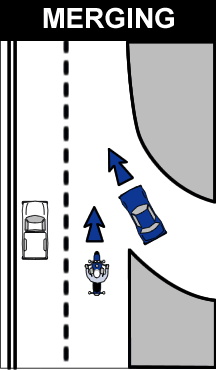
Vehicles Alongside
Do not ride next to passenger vehicles or trucks in other lanes if you do not have to because you might be in the driver’s blind spot. The driver could change lanes without warning.
Also, vehicles in the next lane can block your escape if you come upon danger in your own lane. Speed up or drop back to find a place clear of traffic on both sides.
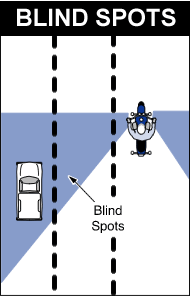
Search, Evaluate, and Execute (SEE)
Experienced motorcycle riders remain aware of what is going on around them. They improve their riding strategy by using SEE, a three-step process for making appropriate judgments and applying them correctly in different traffic situations. SEE stands for, Search, Evaluate, and Execute.
Search
Actively search ahead, to the sides, and behind you to help you avoid potential hazards. How you search and how much time and space you have, can eliminate or reduce harm. Focus even more on finding potential escape routes in or around intersections, shopping areas, schools or construction zones.
Search for factors such as:
- Oncoming traffic that may turn left in front of you.
- Traffic coming from either the left, right, or behind.
- Pedestrians coming out from between parked vehicles.
- Hazardous road conditions.
Evaluate
To predict how a hazard may affect you, it is important to know the speed, distance, and direction the hazard may be moving. Think about how hazards can create risks for you. Anticipate potential problems and have a plan to reduce risks.
- Road and surface characteristics such as potholes, guardrails, bridges, telephone poles and trees will not move into your path but may influence your riding strategy and escape routes.
- Traffic control devices such as traffic signals, regulatory signs, warning signs, and pavement markings will help you evaluate circumstances ahead.
- Vehicles and other traffic may move into your path and increase the likelihood of a collision.
Think about your time and space requirements in order to maintain a margin of safety. You must leave yourself time to react if an emergency arises.
Execute
Carry out your decision. To create more space and minimize harm from any hazard:
- Communicate your presence with lights and/or your horn.
- Adjust your speed as necessary by accelerating, stopping, or slowing.
- Adjust your lane position and/or direction of travel.
Apply the old saying “one step at a time” to handle two or more hazards. Adjust your speed so you can deal with each hazard separately. Then deal with them one at a time as single hazards. Decision-making becomes more complex with three or more hazards. Weigh the consequences of each and give equal distance to the hazards.
In high-risk areas, such as intersections, shopping areas, schools, or construction zones, reduce your speed, and cover the clutch and both brake levers to reduce your reaction time.
Intersections
The greatest potential for conflict and a chance of collision between you and other traffic is at intersections. An intersection is anywhere traffic may cross your path. It can be in the middle of an urban area or at a driveway on a residential street. Over one-half of motorcycle/passenger vehicle collisions are caused by drivers entering a rider’s right-of-way. Vehicles turning left in front of you, including those illegally turning left from the wrong lane, and vehicles on side streets pulling into your lane, are the biggest dangers. Your use of the SEE process at intersections is critical (Refer to this section for the SEE process).
There are no guarantees that others will see you. Never count on “eye contact” as a sign that a driver will yield to you. Too often, a driver can look right at a motorcyclist and still fail to “see” him or her. The only eyes that you can count on are your own. If a vehicle can enter your path, assume it will. Good motorcycle riders are always “looking for trouble” not to get into it, but to stay out of it.
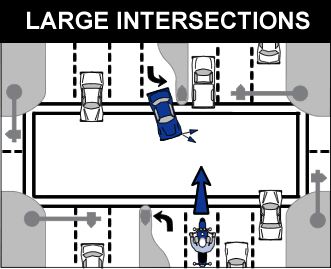
Increase the chances of being seen at intersections. Ride with your headlight on, and in a lane position that provides the best view of oncoming traffic. Maintain enough space around your motorcycle that permits you to take evasive action.
As you approach an intersection, select a lane position that increases your visibility to the driver. Cover the clutch and both brakes to reduce reaction time.
Reduce your speed as you approach an intersection. After entering the intersection, move away from vehicles preparing to turn. Do not change speed or position radically. The driver might think you are preparing to turn.
Blind Intersections
When you approach a blind intersection, move to the position that brings you into another driver’s field of vision at the earliest possible moment. In this picture, the motorcycle rider has moved to the left portion of the lane, away from the parked vehicle, so the driver on the cross street can see him or her as soon as possible.
If you have a stop sign or stop line, stop there first. Then edge forward and stop again, just short of where the cross-traffic lane meets your lane. From this position, lean your body forward and look around buildings, parked vehicles, or bushes to see if anything is coming. Make sure your front wheel stays out of the cross lane of travel while you are looking.
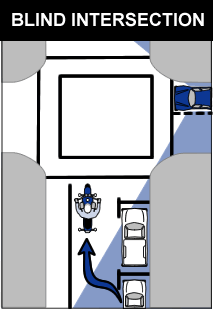
Passing Parked Vehicles
When passing parked vehicles, stay toward the left portion of your lane. This way, you can avoid problems caused by doors opening, drivers getting out of vehicles, or people stepping from between vehicles. If oncoming traffic is present, it is usually best to remain in the center portion of the lane to maximize the space around you.
A bigger problem can occur if a driver pulls away from the curb without checking for traffic from behind. Even if the driver looks, he or she may fail to see you.
In either event,the driver might enter your path. Slow down or change lanes to make room for someone to enter.
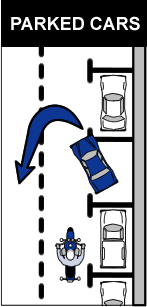
Vehicles making a sudden U-turn are the most dangerous. They may cut you off entirely, blocking the whole roadway and leaving you with no place to go. Since you cannot tell what a driver will do, slow down and get the driver’s attention. Sound your horn and continue with caution.
Parking at the Roadside
Park at an angle of 45 to 90 degrees to the curb with a wheel or fender touching the curb.

Increasing Visibility
In collisions with motorcyclists, drivers often say that they never saw the motorcycle. From ahead or behind, a motorcycle’s outline is much smaller than a passenger vehicle’s. Also, it is hard to see something you are not looking for, and most drivers are not looking for motorcycles. More likely, they are looking through the skinny, two-wheeled silhouette in search of vehicles that may pose a problem to them.
Even if a driver does see you coming, you are not necessarily safe. Smaller vehicles appear farther away and seem to be traveling slower than they actually are. It is common for drivers to pull out in front of motorcyclists, thinking they have plenty of time. Too often, they are wrong.
However, you can do many things to make it easier for others to recognize you and your motorcycle.
Clothing
Most collisions occur in broad daylight. Wear brightly-colored or reflective clothing to increase your chances of being seen.
Bright orange, red, yellow, or green jackets or vests are the best for being seen. Brightly colored helmets can also help others see you.
Reflective material on a vest and on the sides of the helmet will help drivers see you from the side. Reflective material can also be a big help for drivers coming toward you or from behind. Remember, your body is half of the visible surface area of the rider/motorcycle unit.
Headlight
The best way to help others see your motorcycle is to always keep the headlight and, if equipped, running lights on. A motorcycle with its light on is twice as likely to be noticed. Using your high beam during the day and at night increases the chances that oncoming drivers will see you. Use your high beam when it is legal and safe to do so. When it is foggy, use the low beam.
Turn Signals
The turn signals on a motorcycle are similar to those on a vehicle. They tell others what you plan to do.
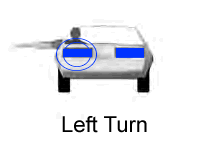
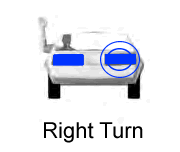
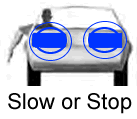
However, due to a rider’s added vulnerability, turn signals are even more important. Use them anytime you plan to change lanes or turn. Signal your left or right turn during the last 100 feet before reaching the turning point. At highway speeds, it is best to signal at least five seconds before changing lanes. Use your turn signals even when you think no one else is around. Your turn signals also make you easier to see. If bright sunlight makes your turn signal lights hard to see, use hand signals.
When you enter a freeway, drivers approaching from behind are more likely to see your turn signal blinking and make room for you.
Using your turn signals before each turn reduces confusion and frustration for the traffic around you. Once you complete your turn, be sure to turn them off or a driver may pull directly into your path, thinking you plan to turn again.
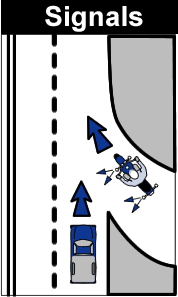
Brake Light
Your motorcycle’s brake light is usually not as noticeable as a vehicle’s, especially when the taillight is on. If the situation permits, help others notice you by flashing your brake light before you slow down. It is especially important to flash your brake light before you slow:
- For a tight, fast turn off a high-speed highway.
- Where others may not expect it (in the middle of a block or at an alley).
If you are being tailgated, it is a good idea to flash your brake light before you slow.
Using Your Mirrors
While it is most important to know what is happening ahead, you cannot ignore situations behind you. Traffic conditions change quickly. To make safe decisions about how to handle trouble ahead, you must know what is going on around you.
Frequent mirror checks should be part of your normal searching routine. Make a special point of using your mirror(s):
- When you are stopped at an intersection. Watch vehicles coming up from behind. If the driver isn’t paying attention, he could be on top of you before he sees you.
- Before you change lanes. Make sure no one is about to pass you. Check the mirror(s) and turn your head to check over your shoulder, on the side of the lane you want to move in to.
- Before you slow down. The driver behind you may not expect you to slow down, or may be unsure about where you will slow down. For example, you signal a turn and the driver thinks you plan to turn at a distant intersection, rather than at a nearer driveway.
Some motorcycles have rounded (convex) mirrors. These mirrors provide a wider view of the road behind than flat mirrors. They also make cars seem farther away than they really are. If you are not used to convex mirrors, you can get familiar with them by:
- Picking out a parked vehicle in your mirror (while you are stopped).
- Forming a mental image of how far away it is.
- Then, turning around and looking to see how close you came.
- Practicing with your mirror(s) until you become a good judge of distance.
- Allowing extra distance before you change lanes.
Head Checks
Checking your mirror(s) is not enough. Motorcycles have “blind spots” just like other vehicles. Before you change lanes, turn your head and check that lane for other vehicles.
On a road with several lanes, check the far lane and the one next to you. A driver in the distant lane may drive into the same space you plan to take.
Frequent head checks should be part of your normal scanning routine. Only by knowing what is happening all around,can you be fully prepared to deal with it.

Horn
Be ready to use your horn to get someone’s attention quickly.
In an emergency, press the horn button loud and long. Be ready to stop or swerve away from the danger.
Remember, a motorcycle’s horn is not as loud as other vehicles’, so use it, but don’t rely on it.
Riding at Night
At night it is harder for you to see and be seen. Wear reflective clothing when riding at night. Picking a motorcycle’s headlight or taillight out of the other lights is not easy for drivers. To make up for this, you should:
- Reduce your speed. Ride even slower than you would during the day, particularly on roads you do not know well. This increases your chances of avoiding a hazard.
- Increase distance. Distances are harder to judge at night than during the day. Your eyes rely upon shadows and light contrasts to determine how far away an object is and how fast it is coming. These contrasts are missing or distorted at night. Open up a three-second or more following distance. Allow more distance to pass and be passed.
- Use the vehicle ahead. The headlights of the vehicle ahead can give you a better view of the road than your high beam. Taillights bouncing up and down can alert you to bumps or rough pavement.
- Use your high beam. Get all the light you can. Use your high beam whenever you are not following or approaching another vehicle. Be visible. Wear reflective clothing materials when riding at night.
- Be flexible about lane position. Change to the lane position that helps you see, be seen, and keep an adequate space cushion.
Collision Avoidance
No matter how careful you are, there will be times when you find yourself in a tight spot. Your chances of getting out safely depend on your ability to react quickly and properly. Often, a collision occurs because a motorcycle rider is not prepared or skilled in collision-avoidance maneuvers.
Two critical skills in avoiding a collision are knowing when and how to stop or swerve. You cannot always stop quickly to avoid an obstacle. You must also be able to swerve around an obstacle.
Most collisions involve riders who:
- Underbrake the front tire and overbrake the rear.
- Did not separate braking from swerving or did not choose to swerve when it was appropriate.
Quick Stops
To stop quickly, apply both brakes at the same time. Do not be shy about using the front brake, but do not “grab” it either. Squeeze the brake lever firmly with continuing steady pressure. If the front wheel locks, release the front brake immediately and then reapply it firmly. At the same time, press down on the rear brake. If you accidentally lock the rear brake on a good traction surface, you can keep it locked until you have completely stopped.
Note Even with a locked rear wheel, you can control the motorcycle on a straight away if it is upright and going in a straight line.
Always use both brakes at the same time to stop. The front brake can provide almost three-quarters of your stopping power.
If you must stop quickly while turning or riding a curve, the best technique is to straighten the motorcycle first and then brake. However, it may not always be possible to straighten the motorcycle and then stop. If you must brake while leaning, apply the brakes lightly and reduce the throttle. As you slow, reduce your lean angle and apply more brake pressure until the motorcycle is straight and maximum brake pressure is possible. Then in the last few feet of stopping, you should “straighten” the handlebars. The motorcycle should now be straight up and in balance.
Swerving or Turning Quickly
Sometimes you may not have enough room to stop, even if you use both brakes properly. An object might appear suddenly in your path or the vehicle ahead might stop abruptly. The only way to avoid a collision may be to turn quickly or swerve around it.
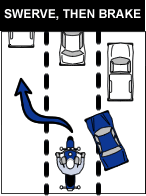

A swerve is any sudden change in direction. It can be two quick turns, or a rapid shift to the side. To swerve, apply a small amount of hand pressure to the handlegrip on the side of your intended direction of escape. This causes the motorcycle to lean quickly. The sharper the turn(s), the more the motorcycle must lean.
Keep your body upright and allow the motorcycle to lean in the direction of the turn. Keep your knees pressed against the tank and your feet solidly on the footrests. Let the motorcycle move underneath you. Make your escape route the target of your vision. Press on the opposite handlegrip once you clear the obstacle and are ready to return to your original direction of travel.
To swerve to the left, press the left handlegrip, then press the right to recover. To swerve to the right, press right, then left. Then press the left or right handlegrip to recover.
If braking is required, separate it from swerving. Brake before or after-never while swerving, especially the front brake as this may cause the motorcycle to fall over.
Cornering
A primary cause of single-vehicle collisions is motorcyclists running wide in a curve or turn causing the motorcycle to leave the roadway or collide with an object.
Every curve is different. Be alert to whether a curve remains constant, gradually widens, gets tighter, or involves multiple turns. Shaded curves keep ice from melting and moisture from evaporating. Also, be aware of leaves.
Ride within your skill level and posted speed limits. Your best path may not always follow the curve of the road.
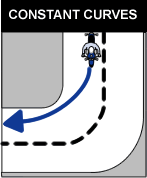
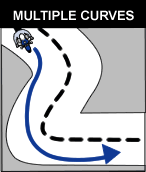
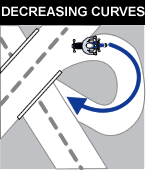
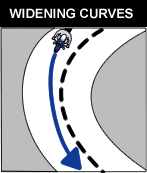
Change your lane position based on traffic, road conditions, and curve of the road. If there is no traffic, start at the outside of a curve to increase your line of sight and the effective radius of the turn. As you turn, move toward the inside of the curve, and as you pass the center, move to the outside to exit.
Another choice is to move to the center of your lane before entering a curve and stay there until you exit. This allows you to see approaching traffic as soon as possible. You can also adjust for traffic “crowding” the center line or debris blocking part of your lane.
Handling Dangerous Surfaces
Your chance of falling or being involved in a collision increases whenever you ride across:
- Uneven surfaces or obstacles.
- Slippery surfaces, such as shaded icy areas, leaves, pine needles, and standing water. Be careful of standing water and puddles as you do not know how deep the water is.
- Railroad tracks or pavement seams.
- Grooves and gratings.
Uneven Surfaces and Obstacles
Watch for uneven road surfaces, such as bumps, broken pavement, potholes, roadway resurfacing where one lane is slightly higher than the other lane, or trash on the highway and shoulders.
Avoid obstacles by slowing or going around them. However, if you must go over the obstacle, first determine if it is possible. Approach it at as close to a 90 degree angle as possible. Look in the direction where you want to go to control your path of travel. If you have to ride over the obstacle, you should:
- Slow down as much as possible before contact.
- Make sure the motorcycle is straight.
- Rises lightly off the seat with your weight on the footrests to absorb the shock with your knees and elbows and avoid being thrown off the motorcycle.
- Just before contact, roll on the throttle slightly (increase engine power) to lighten the front end.
If you ride over an object, pull off the road and check your tires and rims for damage before riding any farther. Make sure nothing is caught in the drive chain or belt.
Slippery Surfaces
Motorcyclists may find it challenging to maintain safe control on surfaces with poor traction, such as:
- Wet pavement, particularly just after it starts to rain and before surface oil washes to the side of the road.
- Gravel roads or where sand and gravel collect.
- Mud, leaves, snow, and ice.
- Lane markings (painted road arrows and crosswalks), steel plates, brick paver crosswalks, and manhole covers, especially when wet.
To ride safely on slippery surfaces:
- Reduce speed. Slow down before you get to a slippery surface to reduce your chances of skidding. When the roadway is slippery, your motorcycle needs more distance to stop. It is especially important to reduce speed before entering wet curves.
- Avoid sudden moves. Any sudden change in speed or direction can cause a skid. Be as smooth as possible when you speed up, shift gears, turn, or brake.
- Use both brakes. The front brake is still effective on a slippery surface. Squeeze the brake lever gradually to avoid locking the front wheel. Remember to use gentle pressure on the rear brake.
- Remember the center of a lane can be hazardous when wet. When it starts to rain, ride in a vehicle’s tire tracks. Often, the left tire track will be the best lane position, depending on traffic and other road conditions as well.
- Watch for oil spots. The center portion of the lane is where most oil, anti-freeze, and other vehicle fluids collect. Position yourself on either side of the center strip and be careful when put your foot down to stop or park. You may slip and fall.
- Be cautious of the edge of the road. Dirt and gravel collect along the sides of the road, especially on curves and ramps leading to and from highways.
- Remember rain dries and snow melts faster on some sections of a road than on others. Patches of ice tend to develop in low or shaded areas and on bridges and overpasses. Wet leaves are just as slippery as wet road surfaces. Ride on the least slippery portion of the lane and reduce your speed.
Cautious riders steer clear of roads covered with ice or snow. If you cannot avoid an icy or snowy surface, keep your motorcycle straight up and proceed as slowly as possible. If you encounter a large surface so slippery that you must coast,or travel at a walking pace, consider letting your feet skim along the surface. If the motorcycle starts to fall, you can catch yourself. Be sure to keep off the brakes. If possible, squeeze the clutch and coast. Attempting this maneuver at anything other than the slowest of speeds could prove hazardous.
Railroad or Trolley Tracks and Pavement Seams
Usually it is safer to ride straight within your lane to cross tracks. Turning to take tracks head-on (at a 90 degree angle) can be more dangerous because your path may carry you into another lane of traffic.
For track and road seams that run parallel to your course, move far enough away from tracks, ruts, or pavement seams to cross at an angle of at least 45 degrees. Then, make a quick, sharp turn. Edging across could catch your tires and throw you off balance.
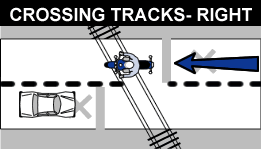
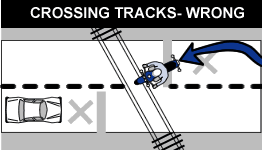
Grooves and Gratings
Riding over rain grooves or bridge gratings may cause your motorcycle to weave. This uneasy, “wandering” feeling is generally not hazardous. Relax and maintain a steady speed and ride straight across. Crossing at an angle forces riders to zigzag to stay in the lane. The zigzag is far more hazardous than the wandering feeling.

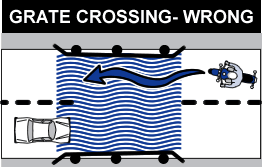
Mechanical Problems
You can find yourself in an emergency the moment something goes wrong with your motorcycle. In dealing with any mechanical problem, take into account the road and traffic conditions you face. Here are some guidelines that can help you handle mechanical problems safely.
Tire Failure
You will seldom hear a tire go flat. If the motorcycle starts handling differently, it may be a tire failure. You must be able to tell from the way the motorcycle reacts if you have tire failure. If one of your tires suddenly loses air, react quickly to keep your balance. Stop riding and check the tires as soon as possible.
If the front tire goes flat, the steering will feel “heavy.” A front-wheel flat is particularly hazardous because it affects your steering. You have to steer well to keep your balance.
If the rear tire goes flat, the back of the motorcycle may jerk or sway from side to side.
If either tire goes flat while riding:
- Hold the handlegrips firmly, ease off the throttle, and keep a straight course.
- If braking is required, gradually apply the brake of the tire that is not flat, if you are sure which one it is.
- When the motorcycle slows, ride to the side of the road, squeeze the clutch, and stop.
Stuck Throttle
Twist the throttle back and forth several times. If the throttle cable is stuck, this may free it. If the throttle stays stuck, immediately operate the engine cut-off switch and pull in the clutch at the same time. This will remove power from the rear wheel, though engine noise may not immediately decline. Once the motorcycle is”under control,” leave the road and stop.
After you have stopped, check the throttle cable carefully to find the trouble. Make certain the throttle works freely before you start riding again.
Wobble
A “wobble” occurs when the front wheel and handlebars suddenly start to shake from side to side at any speed. Most wobbles can be traced to improper loading, unsuitable accessories, or incorrect tire pressure. If you are carrying a heavy load, lighten it. If you cannot lighten the load, shift it. Center the weight lower and farther forward on the motorcycle. Make sure the tire pressure, shock spring pre-load, air shocks, and dampers are at the recommended settings for the weight. Make sure windshields and fairings are mounted properly.
Check for poorly adjusted steering, worn steering parts, a bent, misaligned, or out of balance front wheel, loose wheel bearings or spokes, and swing arm bearings. If none of these are the cause, have the motorcycle thoroughly checked by a qualified professional.
Trying to “accelerate out of a wobble” will only make the motorcycle more unstable. Instead:
- Grip the handlebars firmly, but do not fight the wobble.
- Roll off (decrease engine power) the throttle gradually to slow down. Do not apply the brakes; braking could make the wobble worse.
- Move your weight as far forward and down as possible.
- Leave the road as soon as you can to fix the problem.
Chain Problems
A chain that slips or breaks while you are riding could lock the rear wheel and cause your motorcycle to skid. Chain slippage or breakage can be avoided by proper maintenance.
- Slippage—If the chain slips when you try to speed up or ride uphill, pull off the road. Check the chain and sprockets. Tightening the chain may help. Replace the chain, the sprockets, or both before riding again, if needed.
- Breakage—You will notice an instant loss of power to the rear wheel. Roll off the throttle and brake to a stop.
Engine Seizure
When the engine “locks” or “freezes,” it is usually low on oil. If the engine’s moving parts cannot move smoothly against each other, the engine overheats. The first sign may be a loss of engine power or a change in the engine’s sound. Squeeze the clutch lever to disengage the engine from the rear wheel. Pull off the road and stop. Check the oil. If needed, add oil as soon as possible or the engine will seize. When this happens, the effect is the same as a locked rear wheel. Let the engine cool before restarting.
Animals
Do everything you safely can do to avoid hitting an animal. If you are in traffic; however, remain in your lane.
Flying Objects
From time to time riders are struck by insects, cigarettes thrown from vehicles, or pebbles kicked up by the tires of the vehicle ahead. Avoid following closely behind dump trucks, waster management vehicles, livestock haulers, agricultural vehicles, construction vehicles, or any vehicle towing or hauling items. Debris such as hay, trash, tree limbs, and other loose items being hauled can fall from the vehicles placing you in an unavoidable dangerous situation. If you are wearing face protection, it might get smeared or cracked, making it difficult to see. Without face protection, an object could hit you in the eye, face, or mouth. Whatever happens, keep your eyes on the road and your hands on the handlebars. When safe, pull off the road and repair the damage.
Getting Off the Road
If you need to leave the road to check the motorcycle (or just to rest for a while), be sure you:
- Check the roadside. Make sure the roadside is firm enough to ride on. If it is soft grass, leaves, loose sand, or if you are not sure about it, slow way down before you turn onto it.
- Signal. Drivers behind might not expect you to slow down. Give a clear signal you will be slowing and changing direction. Check your mirror(s) and make a head check before you take any action.
- Pull off the road. Get as far off the road as you can. It can be very hard to see a motorcycle by the side of the road. You do not want someone else leaving the road at the same place you are.
- Park carefully. Loose and sloped shoulders can make setting the side or center kickstand difficult.
Carrying Passengers and Cargo
Only experienced riders should carry passengers or large loads. The extra weight changes the way the motorcycle handles, balances, speeds up, and slows down. Before taking a passenger or a heavy load on the street, practice away from traffic.
Equipment
- Equip and adjust your motorcycle to carry a passenger.
- A proper seat large enough to hold both of you without crowding. You should not sit any farther forward than you usually do.
- Foot rests for the passenger. Firm footing prevents your passenger from falling off and pulling you off, too.
- The same protective apparel and gear recommended for riders.
Adjust the suspension to handle the additional weight. You will probably need to add a few pounds of pressure to the tires if you carry a passenger. (Check your owner’s manual for appropriate settings.) While your passenger sits on the seat with you, adjust the mirror(s) and headlight according to the change in the motorcycle’s angle.
Motorcycles Towing Trailers
Motorcycles towing trailers:
- Must not exceed 55 mph.
- Must remain in the right lane unless it is a four (4) lane highway, then the right two (2) lanes, except when passing.
- Are not allowed in carpool lanes.
For more information see CVC §§630 and 22406 or the Recreational Vehicles and Trailers Handbook (DL 648) or obtain a copy at your local DMV field office.
Instructing Passengers
Even if your passenger is a motorcycle rider, provide complete instructions before you start. Tell your passenger to:
- Get on the motorcycle only after you start the engine.
- Sit as far forward as possible without crowding you.
- Hold firmly to your waist, hips, or belt.
- Keep both feet on the footrests, even when stopped.
- Keep legs away from the muffler(s), chains, or moving parts.
- Stay directly behind you leaning as you lean and looking over your shoulder in the direction of the turn.
- Avoid unnecessary talk or motion. The motorcycle will sway with the passenger’s movement.
Also, tell your passenger to tighten his or her hold when you:
- Approach surface problems.
- Are about to start from a stop.
- Warn that you will make a sudden move.
Riding With Passengers
Your motorcycle will respond more slowly with a passenger. The heavier your passenger, the longer it will take to slow down and speed up-especially on a light-duty motorcycle.
- Ride a little slower, especially when taking curves, corners, or bumps.
- Begin slowing sooner as you approach a stop.
- Open up a larger cushion of space ahead and to the sides.
- Wait for larger gaps to cross,enter, or merge with traffic.
Warn your passenger of these special conditions: Starting, stopping quickly, turning sharply, or riding over bumps. Turn your head slightly to make yourself understood, but keep your eyes on the road ahead.
Carrying Loads
Most motorcycles are not designed to carry much cargo. Small loads can be carried safely, if positioned and fastened properly.
- Keep the load low. Fasten loads securely, or put them in saddlebags. Stacking loads against a sissybar or frame on the back of the seat raises the motorcycle’s center of gravity and shifts its balance.
- Keep the load forward. Place the load over, or in front of, the rear axle. Tank bags keep loads forward, but use caution when loading hard or sharp objects. Make sure the tank bag does not interfere with handlebars or controls. Mounting a load behind the rear axle affects how the motorcycle turns and brakes. It can also cause a wobble.
- Distribute the load evenly. Load saddle bags with about the same weight. An uneven load can cause the motorcycle to drift to one side.
- Secure the load. Fasten the load securely with elastic cords (bungee cords or nets). Elastic cords with more than one attachment point per side are more secure. A tight load won’t catch in the wheel or chain, causing it to lock up and skid. Ropes tend to stretch and knots can come loose, permitting the load to shift or fall.
- Check the load. Stop and check the load often to make sure it has not worked loose or moved.
Group Riding
If you ride with others, do it in a way that promotes safety and doesn’t interfere with the flow of traffic.
Keep the Group Small
Small groups make it easier and safer for other drivers to get around them. A small number isn’t separated as easily by traffic or red lights. Some riders won’t always be hurrying to catch up. If your group is larger than four or five riders, divide it into two or more smaller groups.
Keep the Group Together
- Brief. Perform a preride overview of the route, hand signals for single-file formation and what to do if a hazard is encountered.
- Plan. The leader should look ahead for changes and signal early so there is plenty of time for everyone to follow. Start lane changes early to permit everyone to complete the lane change safely.
- Put beginners up front. Place inexperienced riders behind the leader so the more experienced riders can watch them.
- Monitor those behind. Let the last rider set the pace. Use your mirror(s) to keep an eye on the rider behind. If a rider falls behind, everyone should slow down a little to stay together.
- Know the route. Make sure everyone knows the route. Plan frequent stops on long rides.
Keep Your Distance
Maintain close ranks but at the same time keep a safe distance to allow each rider in the group time and space to react to hazards. A close group takes up less space on the highway, is easier to see, and is less likely to be separated. However, this formation must be done properly.
- Do not pair up. Never operate directly alongside another rider. There is no place to go to avoid a car or a hazard on the road. Wait until you are both stopped to talk.
- Staggered formation. This is the best way to keep ranks close and maintain an adequate space cushion. The leader rides in the left portion of the lane while the second rider stays one second behind in the right portion of the lane. A third rider rides in the left portion of the lane two seconds behind the first rider. The fourth rider keeps a two-second distance behind the second rider. This formation keeps the group close and permits each rider a safe distance from others ahead, behind, and to the sides.
-
Passing in formation. Riders in a staggered formation should pass one at a time.
- First, the lead rider pulls out and passes when safe. After passing, the leader returns to the left portion of the lane and continues riding at “passing speed” to open room for the next rider.
- After the first rider passes safely, the second rider moves up to the left portion of the lane and watches for a safe chance to pass. After passing, this rider returns to the right portion of the lane and opens up room for the next rider.
- Some people suggest that the leader should move to the right portion of the lane after passing a vehicle. This is not a good idea. It encourages the second rider to pass and return to the lane before there is a large enough space cushion in front of the passed vehicle. It is simpler and safer to wait until there is enough room ahead of the passed vehicle to allow each rider to move into the same position held before the pass.
- Single-file formation. Move into a single-file formation when riding curves, turning, and entering or leaving a highway.
